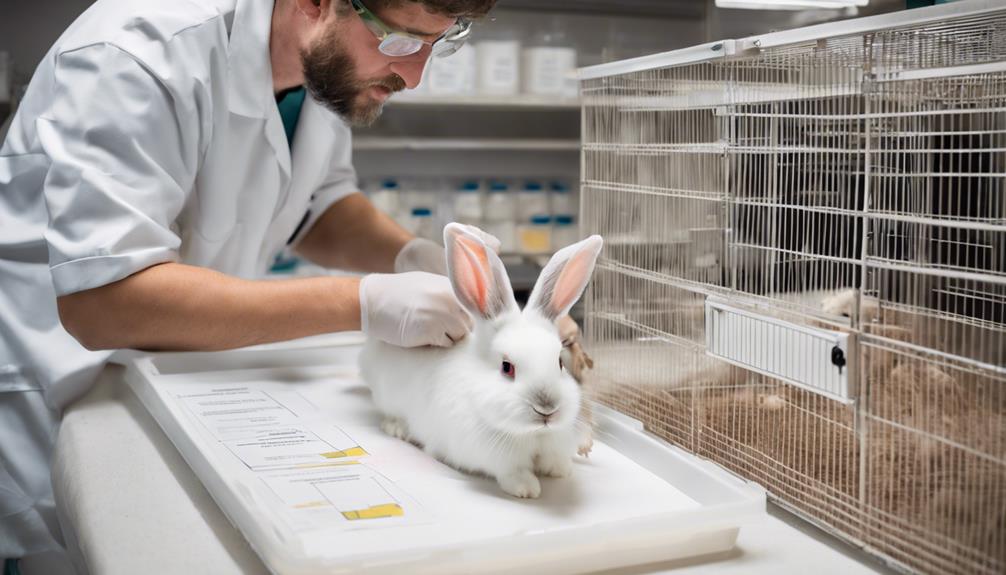10 Best Practices for Ethical Rabbit Research Treatment
To ensure ethical treatment in rabbit research, prioritize their well-being. Offer adequate housing with 12 square feet per rabbit, comfortable flooring, and ideal environmental conditions. Handle them gently, avoiding stress with calm approaches and proper restraint. Provide regular veterinary care, tailored health plans, and effective pain management. Enrich their environment with various activities and social interactions for mental and emotional health. Maintain ethical breeding practices, genetic diversity, and transparency in research protocols. By following these best practices, you can ensure the welfare and scientific integrity of your research subjects.
Providing Adequate Housing
When planning the housing for research rabbits, ensure that it meets their physical and behavioral needs in a manner that promotes their well-being and allows for natural behaviors. Space requirements are crucial for the health and happiness of research rabbits. Each rabbit should have enough space to exhibit normal behaviors such as hopping, stretching, and standing on their hind legs without restriction. A general guideline is to provide at least 12 square feet of space per rabbit, with additional space for each additional rabbit to prevent overcrowding.
Flooring options play a significant role in the comfort of research rabbits. Opt for flooring that's soft and comfortable to prevent injuries and promote good foot health. Solid flooring with a soft covering such as rubber mats or bedding is ideal to cushion their feet. Wire flooring should be avoided as it can cause pain, discomfort, and foot problems.
Temperature control is essential to ensure the well-being of research rabbits. Maintain a consistent temperature between 60-70°F to prevent heat stress or hypothermia. Lighting needs should also be considered to mimic natural daylight cycles. Provide a balance of light and dark periods to regulate their circadian rhythm and promote normal behavior patterns. Natural light is preferable, but if not possible, artificial lighting with timers can be used to maintain a consistent light schedule.
Implementing Proper Handling Techniques
To ensure the well-being and safety of research rabbits, practitioners must employ proper handling techniques with care and precision. Proper restraint is crucial when handling rabbits to prevent injury and minimize stress. When picking up a rabbit, always support their hindquarters to prevent them from kicking or injuring themselves. Use both hands to gently but securely hold the rabbit, avoiding excessive pressure on their delicate bodies. It's important to approach the rabbit calmly and confidently to help them feel more at ease during handling.
Gentle handling is essential to maintain the physical and emotional well-being of research rabbits. Avoid sudden movements or loud noises that can startle the rabbit. Speak softly to provide reassurance and create a calm environment. When transferring a rabbit from one place to another, do so smoothly and without jerking motions. Always be mindful of the rabbit's comfort and safety throughout the handling process.
Additionally, it's recommended to train all personnel involved in handling research rabbits on proper techniques to ensure consistency and minimize the risk of accidents. Regularly assess the handling practices and make adjustments as needed to improve the welfare of the rabbits. By implementing proper restraint and gentle handling techniques, researchers can create a safe and comfortable environment for their rabbit subjects.
Ensuring Veterinary Care
Proper veterinary care is essential for maintaining the health and well-being of research rabbits. Veterinary oversight plays a crucial role in ensuring the ethical treatment and welfare of these animals. Research outcomes and the well-being of the rabbits are directly impacted by the quality of veterinary care they receive.
Ethical considerations are paramount when it comes to providing veterinary care for research rabbits. Veterinarians involved in rabbit research must adhere to strict ethical guidelines to guarantee the humane treatment of the animals. This includes ensuring that any interventions or treatments are necessary, appropriate, and conducted with the well-being of the rabbits as the top priority.
Regular veterinary check-ups are essential to monitor the health status of research rabbits. Early detection of any health issues can prevent unnecessary suffering and ensure the well-being of the animals. Additionally, veterinarians play a key role in designing and implementing health management plans that are tailored to the specific needs of research rabbits.
Monitoring Environmental Conditions
In maintaining the ethical treatment of research rabbits, meticulous monitoring of environmental conditions is imperative. Environmental monitoring ensures that the rabbits are kept in a safe and comfortable space where they can thrive and contribute meaningfully to research efforts.
- Regular Temperature Checks: Monitoring the temperature within rabbit housing areas is crucial to prevent heat stress or hypothermia. Maintain suitable temperature levels to keep the rabbits healthy and stress-free.
- Humidity Control: Regulating humidity levels is essential for the rabbits' well-being. High humidity can lead to respiratory issues, while low humidity can cause skin problems. Monitor and adjust humidity levels accordingly.
- Proper Ventilation: Good air quality is vital for the health of research rabbits. Ensure proper ventilation to prevent the buildup of harmful gases and maintain a fresh and clean environment.
- Lighting Conditions: Monitoring lighting conditions is important for the rabbits' circadian rhythm. Provide a natural light cycle or simulate it with artificial lighting to support their biological needs.
Offering Enrichment Activities
Maintaining the ethical treatment of research rabbits involves providing a variety of enrichment activities to promote their well-being and mental stimulation. Enrichment programs play a crucial role in enhancing the lives of research rabbits by encouraging natural behaviors and cognitive engagement. To ensure the rabbits' welfare, it's essential to implement a well-rounded enrichment plan that caters to their physical and psychological needs.
Enrichment programs should focus on stimulating the rabbits' minds through activities such as puzzle feeders, interactive toys, and hiding treats for foraging. These mental stimulation exercises help prevent boredom, encourage exploration, and promote behavioral adaptations that are closer to their natural instincts. Additionally, incorporating social interactions with compatible rabbit companions can further enrich their environment and provide opportunities for socialization, enhancing their overall well-being.
When designing enrichment activities, consider the rabbits' preferences, species-specific behaviors, and individual personalities. Observing their responses to different stimuli can help tailor the enrichment program to suit their needs effectively. Remember to rotate and introduce new enrichment items regularly to prevent habituation and ensure continued engagement.
Minimizing Stress During Procedures
To ensure the well-being of research rabbits, focus on minimizing stress during procedures by implementing gentle handling techniques and providing a calm environment conducive to their comfort and safety.
Stress reduction is crucial in maintaining the welfare of research rabbits. Paying attention to their behavioral cues can help in identifying signs of stress such as freezing, increased heart rate, or thumping.
Here are some key strategies to minimize stress during procedures:
- Gentle Handling: Utilize soft and slow movements when handling rabbits to avoid startling them and causing unnecessary stress.
- Quiet Environment: Ensure that the area where procedures are conducted is quiet and free from loud noises to create a calming atmosphere for the rabbits.
- Comfort Measures: Provide familiar bedding or blankets that carry their scent to offer comfort and security during procedures.
- Pain Management: Administer pain relief medication as necessary to alleviate any discomfort or pain experienced by the rabbits during and after procedures.
Promoting Socialization

Promote the well-being of research rabbits by fostering positive social interactions among them to enhance their mental and emotional health. Socialization benefits research rabbits in various ways, impacting their behavioral responses positively. When rabbits have the opportunity to interact with their companions, they exhibit reduced levels of stress and anxiety. Social interactions create a sense of security and comfort, leading to a more relaxed and content demeanor in research rabbits.
Positive socialization can also enhance the cognitive abilities of rabbits. Engaging in social activities stimulates their minds, encouraging mental agility and problem-solving skills. Research has shown that rabbits who've regular social interactions are more likely to display enriched behaviors such as exploring their environment, engaging in playful activities, and exhibiting curiosity.
Moreover, promoting socialization among research rabbits can help prevent feelings of loneliness and isolation. Rabbits are social animals by nature and thrive in the presence of their peers. Lack of social interaction can lead to negative behavioral impacts such as aggression, depression, and decreased overall well-being. Therefore, providing opportunities for rabbits to socialize with each other is essential in maintaining their mental and emotional health in research settings.
Supporting Ethical Breeding Practices
Support ethical breeding practices to ensure the welfare and health of research rabbits is prioritized throughout their lifecycle. When it comes to breeding research rabbits, following breeding standards and ethical guidelines is crucial. Responsible breeding practices not only promote the health and well-being of the rabbits but also contribute to the reliability and validity of research outcomes.
- Breeding standards: Adhering to established breeding standards helps maintain genetic diversity and prevents the propagation of hereditary diseases within rabbit populations.
- Ethical guidelines: Following ethical guidelines ensures that breeding practices are conducted with respect for the rabbits' physical and emotional needs, promoting a humane approach to research animal breeding.
- Responsible breeding: Responsible breeding involves careful selection of breeding pairs based on health, temperament, and genetic background to produce healthy offspring.
- Welfare considerations: Prioritizing the welfare of breeding rabbits includes providing appropriate living conditions, nutrition, and veterinary care to ensure their well-being throughout the breeding process.
Documenting Research Protocols

For comprehensive and transparent research practices, meticulous documentation of research protocols is imperative. Data recording plays a crucial role in ensuring the validity and reproducibility of research findings. It's essential to document all aspects of the research process, from the initial study design to the final results obtained.
Ethical considerations must be at the forefront when documenting research protocols. Researchers should clearly outline how they plan to address potential ethical issues that may arise during the study. This includes detailing how the welfare of research subjects, in this case, rabbits, will be protected throughout the research process.
Protocol transparency is key to upholding research integrity. Transparent documentation allows for better scrutiny of the research methods employed and promotes accountability. Researchers should provide detailed descriptions of the procedures followed, including any modifications made during the study to ensure transparency and reproducibility.
Prioritizing Rabbit Welfare
To ensure the ethical treatment of research subjects, particularly rabbits, it's paramount to prioritize their welfare throughout all stages of the research process. Ethical handling and welfare assessment are crucial components in maintaining the well-being of rabbits involved in research studies.
Here are some key considerations to prioritize rabbit welfare:
- Ethical Handling: Proper and gentle handling techniques should be employed to minimize stress and ensure the comfort of the rabbits during all interactions.
- Welfare Assessment: Regular assessments should be conducted to evaluate the overall welfare of the rabbits, including their physical health, behavior, and emotional well-being.
- Behavioral Monitoring: Continuous monitoring of rabbit behavior is essential to identify any signs of distress or discomfort promptly. This allows for timely intervention to address welfare concerns.
- Pain Management: Implementing effective pain management protocols is essential to alleviate any pain or discomfort experienced by the rabbits during research procedures. This includes the use of appropriate analgesics and ensuring that pain relief measures are tailored to individual needs.
Frequently Asked Questions
Can Rabbits Be Trained for Specific Research Tasks?
Yes, rabbits can be trained for specific research tasks. The training effectiveness varies depending on the task specificity and the ethical considerations involved.
It's crucial to prioritize animal welfare when designing training protocols for rabbits. By considering their well-being and implementing ethical practices, researchers can effectively train rabbits for specific tasks while ensuring their treatment is humane and respectful.
How Often Should Rabbits Undergo Behavioral Assessments?
To ensure the well-being of the rabbits and the accuracy of research data, it's essential to conduct behavioral assessments regularly. Assessments should be scheduled at appropriate intervals while considering the ethical implications of the process.
What Measures Are Taken to Prevent Inter-Rabbit Aggression?
To prevent inter-rabbit aggression, various measures can be implemented. Utilize socialization techniques to introduce rabbits gradually. Implement behavioral monitoring to identify early signs of aggression. Ensure proper handling procedures are followed to minimize stress. Optimal housing arrangements, such as offering separate enclosures for rabbits exhibiting aggressive behavior, can help prevent conflicts.
Are There Guidelines for Introducing New Enrichment Items?
When introducing new enrichment items for rabbits, ensure you consider their effectiveness in promoting mental and physical stimulation.
Challenges may arise during implementation due to individual preferences and behavioral differences among rabbits. It's crucial to carefully observe their reactions and adjust the enrichment accordingly to meet their needs.
Is There a Specific Protocol for Euthanasia in Research Rabbits?
When considering euthanasia protocols for research rabbits, it's crucial to prioritize ethical considerations. Following established guidelines ensures the welfare of animals and minimizes their suffering. Implementing proper protocols not only adheres to ethical standards but also impacts the quality and reliability of research outcomes.
Conclusion
In conclusion, following these 10 best practices for ethical rabbit research treatment is crucial in ensuring the well-being and welfare of these animals.
By providing proper housing, handling, veterinary care, and enrichment activities, researchers can conduct their studies ethically and responsibly.
It's important to prioritize the welfare of rabbits in research settings, promoting a culture of respect and compassion for these sentient beings.
Adhering to these practices is essential for upholding ethical standards in rabbit research.
